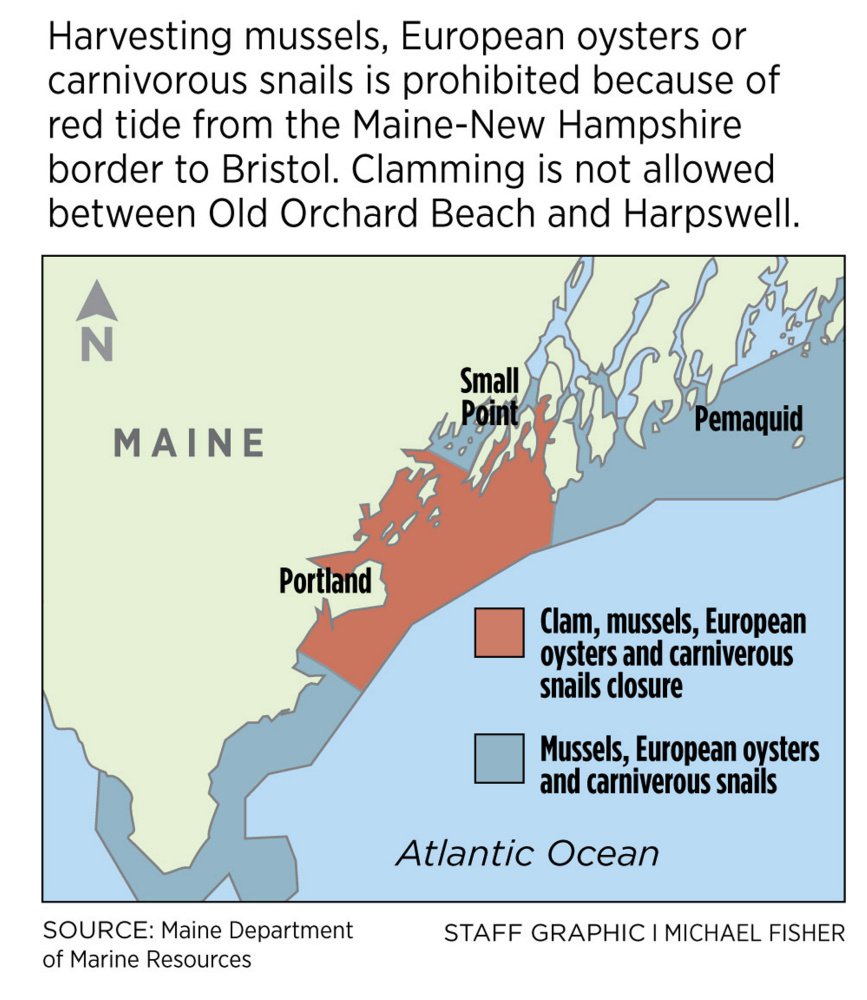A large segment of the Maine coastline between Old Orchard Beach and Harpswell was declared off-limits to clam harvesting this week because of red tide, adding further restrictions to a much larger area that has been under a shellfish harvesting prohibition for more than a month.
The Maine Department of Marine Resources and its Bureau of Public Health made the announcement on Monday, warning that the ban on clam harvesting takes effect immediately because of the threat of paralytic shellfish poisoning caused by red tide.
According to the department’s announcement, it is unlawful now to dig for clams in the area between Old Orchard Beach and Harpswell.
The clam harvesting ban, which applies only to soft-shell, hard-shell and razor clams, will affect clam digging areas on Cousins Island in Yarmouth, Chebeague Island in Cumberland, Woodward Point in Brunswick, Foster Point in West Bath, and Basin Point in Harpswell.
Jeff Nichols, a spokesman for the marine resources department, said a regional ban that prohibited the harvesting of mussels, European oysters and carnivorous snails was implemented April 3. The regional shellfish ban affects the area between South Berwick in York County and Pemaquid Point in the Lincoln County community of Bristol, he said. Clam harvesting may still occur in flats to the south of Old Orchard Beach and north of Harpswell under the regional ban.
Nichols said the department’s public health bureau estimates that roughly 100 clam harvesters will be affected by this week’s ban.
Staff from the state’s Marine Resources Biotoxin Monitoring Program will test shellfish areas for red tide, and once clams flats are deemed safe, they will be reopened.
Nichols said the larger, regional shellfish closure occurs annually as a precaution because mussels, European oysters and carnivorous snails are less effective at filtering toxins – compared to softshell clams.
Nichols said algal blooms flare up nearly every year, and often in spring. They are commonly referred to in Maine as “red tide,” but that is a misnomer, according to the department.
An explanation posted on the department’s website says that red tides are actually “harmful algal blooms,” which do not always turn waters red when toxins are present. Red tide closures occur when high amounts of a toxin that is found in some of types of microscopic ocean algae are measured in shellfish tissue.
Harmful algal blooms typically occur in Maine between April and October.
People usually display symptoms of paralytic shellfish poisoning within two hours of eating a toxic food. Mild symptoms include numbness and tingling of the face, arms and legs, followed by headache, dizziness, nausea and muscular uncoordination. Severe symptoms may include muscle paralysis and respiratory failure.
Shellfish poisoning has been reported in Maine in 2007, 2008 and 2009, and each case involved contaminated shellfish taken from areas closed to shellfish harvesting, according to the marine resources department.
Dennis Hoey can be contacted at 791-6365 or at:
dhoey@pressherald.com
Send questions/comments to the editors.




Success. Please wait for the page to reload. If the page does not reload within 5 seconds, please refresh the page.
Enter your email and password to access comments.
Hi, to comment on stories you must . This profile is in addition to your subscription and website login.
Already have a commenting profile? .
Invalid username/password.
Please check your email to confirm and complete your registration.
Only subscribers are eligible to post comments. Please subscribe or login first for digital access. Here’s why.
Use the form below to reset your password. When you've submitted your account email, we will send an email with a reset code.